Leadership Management: Risk Management Project - Essay & Case Study
VerifiedAdded on 2023/01/19
|17
|5864
|79
Project
AI Summary
This project comprises an essay and a case study focused on managing risk within organizations. The essay explores the impact of human error, the importance of a just culture, and the application of decision theory in risk management. It examines different types of errors, the Swiss Cheese Model, and the role of employee culture in achieving organizational goals. The essay also discusses applicable theories like decision theory, risk appetite, and expected value. The case study delves into identifying hazards, evaluating risk assessment plans, and the role of technology in reducing errors. It assesses the efficacy of the risk assessment plan and the company's overall safety strategy. The project emphasizes the need for accurate information, employee training, and compliance with regulations to mitigate risks effectively and ensure organizational success. The analysis highlights the interconnectedness of risk management, leadership, and organizational culture in fostering a safe and productive work environment.
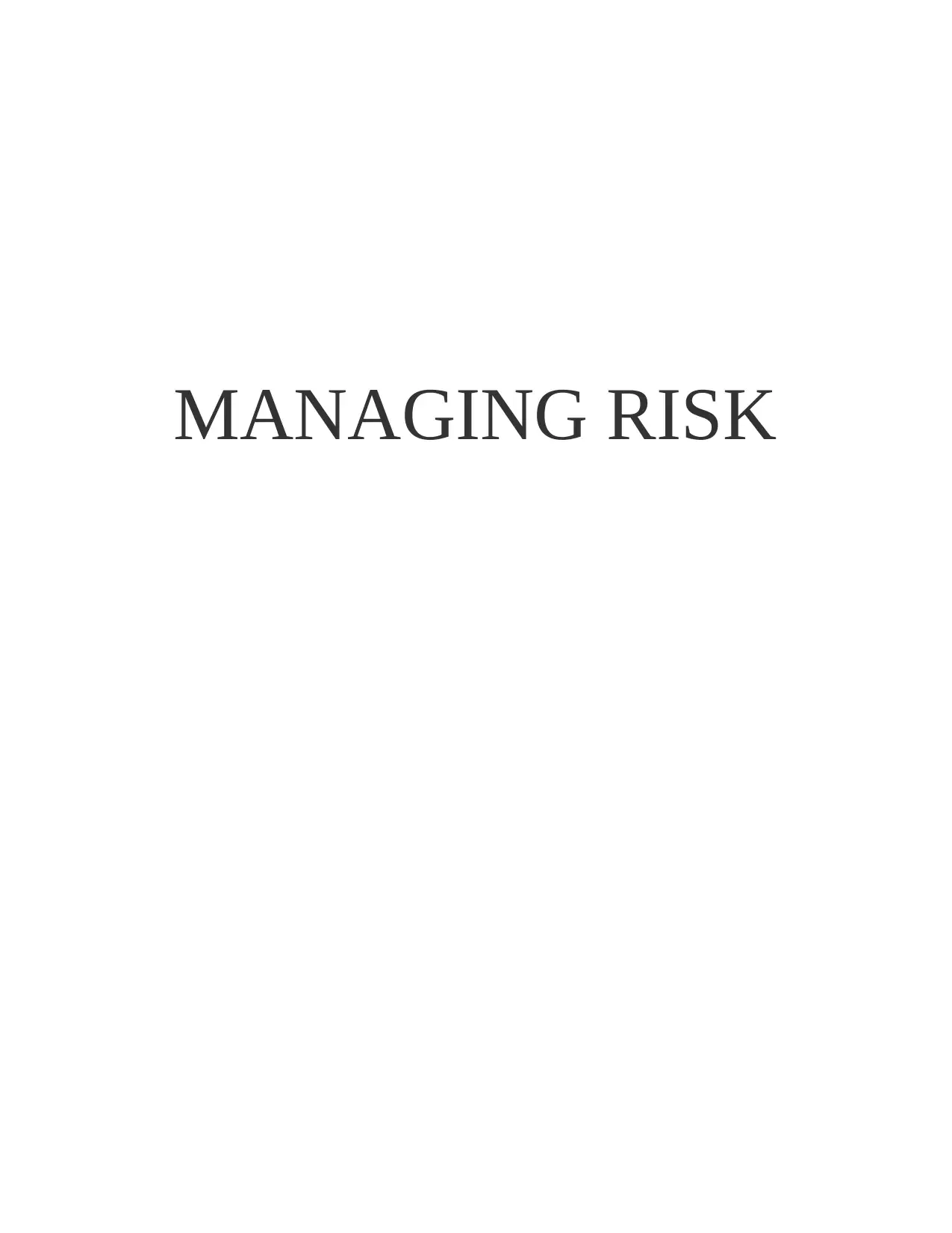
MANAGING RISK
Paraphrase This Document
Need a fresh take? Get an instant paraphrase of this document with our AI Paraphraser
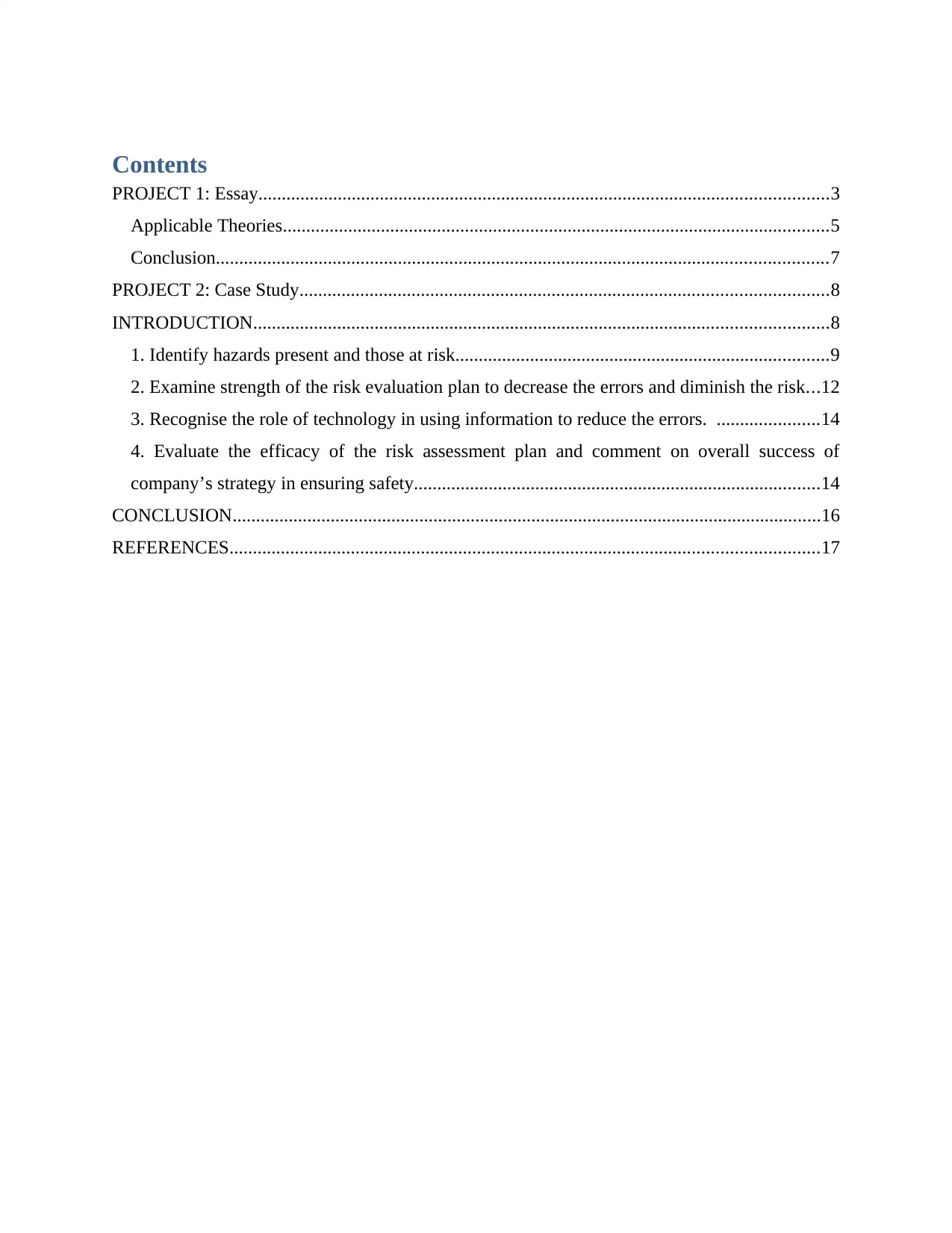
Contents
PROJECT 1: Essay..........................................................................................................................3
Applicable Theories.....................................................................................................................5
Conclusion...................................................................................................................................7
PROJECT 2: Case Study.................................................................................................................8
INTRODUCTION...........................................................................................................................8
1. Identify hazards present and those at risk................................................................................9
2. Examine strength of the risk evaluation plan to decrease the errors and diminish the risk...12
3. Recognise the role of technology in using information to reduce the errors. ......................14
4. Evaluate the efficacy of the risk assessment plan and comment on overall success of
company’s strategy in ensuring safety.......................................................................................14
CONCLUSION..............................................................................................................................16
REFERENCES..............................................................................................................................17
PROJECT 1: Essay..........................................................................................................................3
Applicable Theories.....................................................................................................................5
Conclusion...................................................................................................................................7
PROJECT 2: Case Study.................................................................................................................8
INTRODUCTION...........................................................................................................................8
1. Identify hazards present and those at risk................................................................................9
2. Examine strength of the risk evaluation plan to decrease the errors and diminish the risk...12
3. Recognise the role of technology in using information to reduce the errors. ......................14
4. Evaluate the efficacy of the risk assessment plan and comment on overall success of
company’s strategy in ensuring safety.......................................................................................14
CONCLUSION..............................................................................................................................16
REFERENCES..............................................................................................................................17
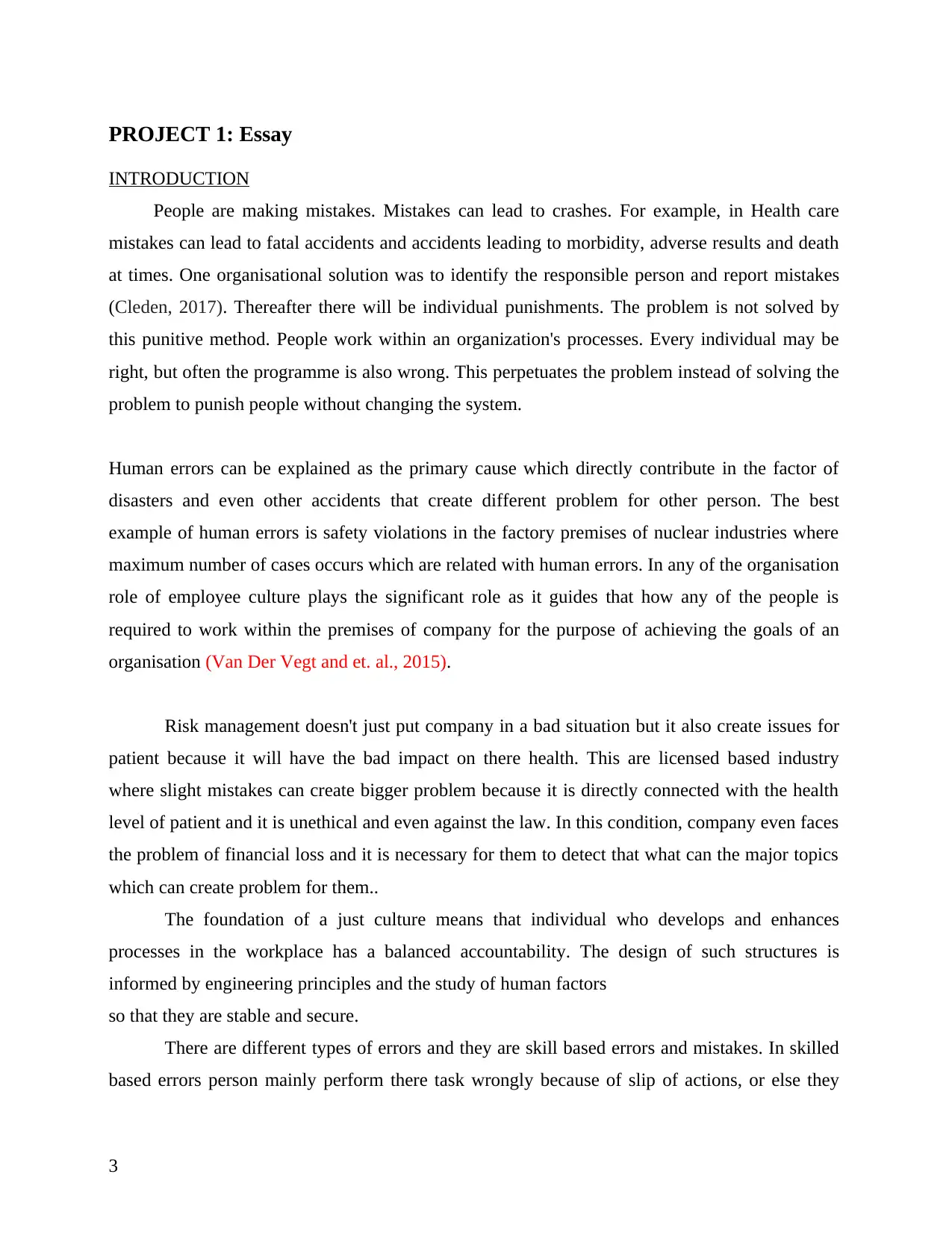
PROJECT 1: Essay
INTRODUCTION
People are making mistakes. Mistakes can lead to crashes. For example, in Health care
mistakes can lead to fatal accidents and accidents leading to morbidity, adverse results and death
at times. One organisational solution was to identify the responsible person and report mistakes
(Cleden, 2017). Thereafter there will be individual punishments. The problem is not solved by
this punitive method. People work within an organization's processes. Every individual may be
right, but often the programme is also wrong. This perpetuates the problem instead of solving the
problem to punish people without changing the system.
Human errors can be explained as the primary cause which directly contribute in the factor of
disasters and even other accidents that create different problem for other person. The best
example of human errors is safety violations in the factory premises of nuclear industries where
maximum number of cases occurs which are related with human errors. In any of the organisation
role of employee culture plays the significant role as it guides that how any of the people is
required to work within the premises of company for the purpose of achieving the goals of an
organisation (Van Der Vegt and et. al., 2015).
Risk management doesn't just put company in a bad situation but it also create issues for
patient because it will have the bad impact on there health. This are licensed based industry
where slight mistakes can create bigger problem because it is directly connected with the health
level of patient and it is unethical and even against the law. In this condition, company even faces
the problem of financial loss and it is necessary for them to detect that what can the major topics
which can create problem for them..
The foundation of a just culture means that individual who develops and enhances
processes in the workplace has a balanced accountability. The design of such structures is
informed by engineering principles and the study of human factors
so that they are stable and secure.
There are different types of errors and they are skill based errors and mistakes. In skilled
based errors person mainly perform there task wrongly because of slip of actions, or else they
3
INTRODUCTION
People are making mistakes. Mistakes can lead to crashes. For example, in Health care
mistakes can lead to fatal accidents and accidents leading to morbidity, adverse results and death
at times. One organisational solution was to identify the responsible person and report mistakes
(Cleden, 2017). Thereafter there will be individual punishments. The problem is not solved by
this punitive method. People work within an organization's processes. Every individual may be
right, but often the programme is also wrong. This perpetuates the problem instead of solving the
problem to punish people without changing the system.
Human errors can be explained as the primary cause which directly contribute in the factor of
disasters and even other accidents that create different problem for other person. The best
example of human errors is safety violations in the factory premises of nuclear industries where
maximum number of cases occurs which are related with human errors. In any of the organisation
role of employee culture plays the significant role as it guides that how any of the people is
required to work within the premises of company for the purpose of achieving the goals of an
organisation (Van Der Vegt and et. al., 2015).
Risk management doesn't just put company in a bad situation but it also create issues for
patient because it will have the bad impact on there health. This are licensed based industry
where slight mistakes can create bigger problem because it is directly connected with the health
level of patient and it is unethical and even against the law. In this condition, company even faces
the problem of financial loss and it is necessary for them to detect that what can the major topics
which can create problem for them..
The foundation of a just culture means that individual who develops and enhances
processes in the workplace has a balanced accountability. The design of such structures is
informed by engineering principles and the study of human factors
so that they are stable and secure.
There are different types of errors and they are skill based errors and mistakes. In skilled
based errors person mainly perform there task wrongly because of slip of actions, or else they
3
⊘ This is a preview!⊘
Do you want full access?
Subscribe today to unlock all pages.

Trusted by 1+ million students worldwide
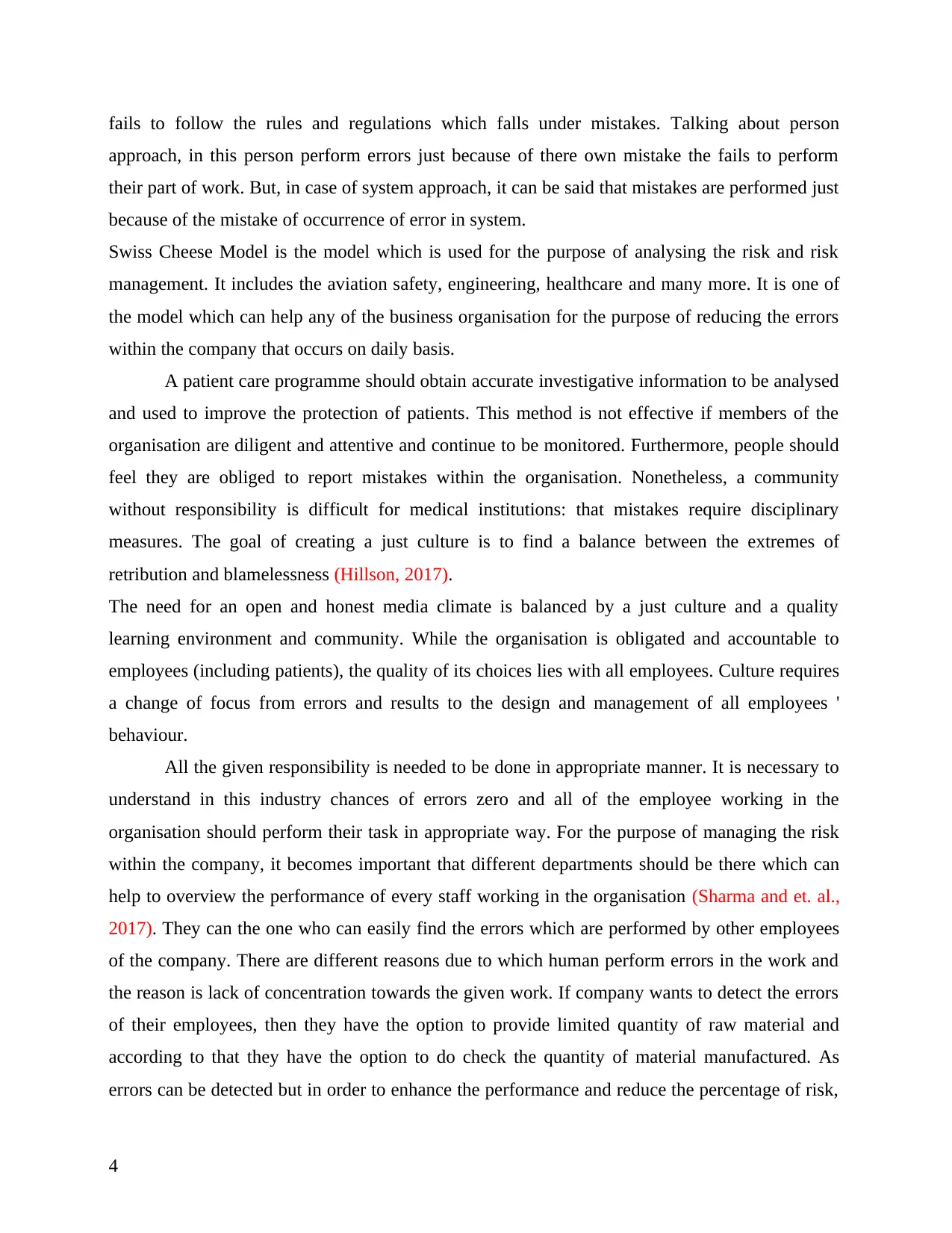
fails to follow the rules and regulations which falls under mistakes. Talking about person
approach, in this person perform errors just because of there own mistake the fails to perform
their part of work. But, in case of system approach, it can be said that mistakes are performed just
because of the mistake of occurrence of error in system.
Swiss Cheese Model is the model which is used for the purpose of analysing the risk and risk
management. It includes the aviation safety, engineering, healthcare and many more. It is one of
the model which can help any of the business organisation for the purpose of reducing the errors
within the company that occurs on daily basis.
A patient care programme should obtain accurate investigative information to be analysed
and used to improve the protection of patients. This method is not effective if members of the
organisation are diligent and attentive and continue to be monitored. Furthermore, people should
feel they are obliged to report mistakes within the organisation. Nonetheless, a community
without responsibility is difficult for medical institutions: that mistakes require disciplinary
measures. The goal of creating a just culture is to find a balance between the extremes of
retribution and blamelessness (Hillson, 2017).
The need for an open and honest media climate is balanced by a just culture and a quality
learning environment and community. While the organisation is obligated and accountable to
employees (including patients), the quality of its choices lies with all employees. Culture requires
a change of focus from errors and results to the design and management of all employees '
behaviour.
All the given responsibility is needed to be done in appropriate manner. It is necessary to
understand in this industry chances of errors zero and all of the employee working in the
organisation should perform their task in appropriate way. For the purpose of managing the risk
within the company, it becomes important that different departments should be there which can
help to overview the performance of every staff working in the organisation (Sharma and et. al.,
2017). They can the one who can easily find the errors which are performed by other employees
of the company. There are different reasons due to which human perform errors in the work and
the reason is lack of concentration towards the given work. If company wants to detect the errors
of their employees, then they have the option to provide limited quantity of raw material and
according to that they have the option to do check the quantity of material manufactured. As
errors can be detected but in order to enhance the performance and reduce the percentage of risk,
4
approach, in this person perform errors just because of there own mistake the fails to perform
their part of work. But, in case of system approach, it can be said that mistakes are performed just
because of the mistake of occurrence of error in system.
Swiss Cheese Model is the model which is used for the purpose of analysing the risk and risk
management. It includes the aviation safety, engineering, healthcare and many more. It is one of
the model which can help any of the business organisation for the purpose of reducing the errors
within the company that occurs on daily basis.
A patient care programme should obtain accurate investigative information to be analysed
and used to improve the protection of patients. This method is not effective if members of the
organisation are diligent and attentive and continue to be monitored. Furthermore, people should
feel they are obliged to report mistakes within the organisation. Nonetheless, a community
without responsibility is difficult for medical institutions: that mistakes require disciplinary
measures. The goal of creating a just culture is to find a balance between the extremes of
retribution and blamelessness (Hillson, 2017).
The need for an open and honest media climate is balanced by a just culture and a quality
learning environment and community. While the organisation is obligated and accountable to
employees (including patients), the quality of its choices lies with all employees. Culture requires
a change of focus from errors and results to the design and management of all employees '
behaviour.
All the given responsibility is needed to be done in appropriate manner. It is necessary to
understand in this industry chances of errors zero and all of the employee working in the
organisation should perform their task in appropriate way. For the purpose of managing the risk
within the company, it becomes important that different departments should be there which can
help to overview the performance of every staff working in the organisation (Sharma and et. al.,
2017). They can the one who can easily find the errors which are performed by other employees
of the company. There are different reasons due to which human perform errors in the work and
the reason is lack of concentration towards the given work. If company wants to detect the errors
of their employees, then they have the option to provide limited quantity of raw material and
according to that they have the option to do check the quantity of material manufactured. As
errors can be detected but in order to enhance the performance and reduce the percentage of risk,
4
Paraphrase This Document
Need a fresh take? Get an instant paraphrase of this document with our AI Paraphraser
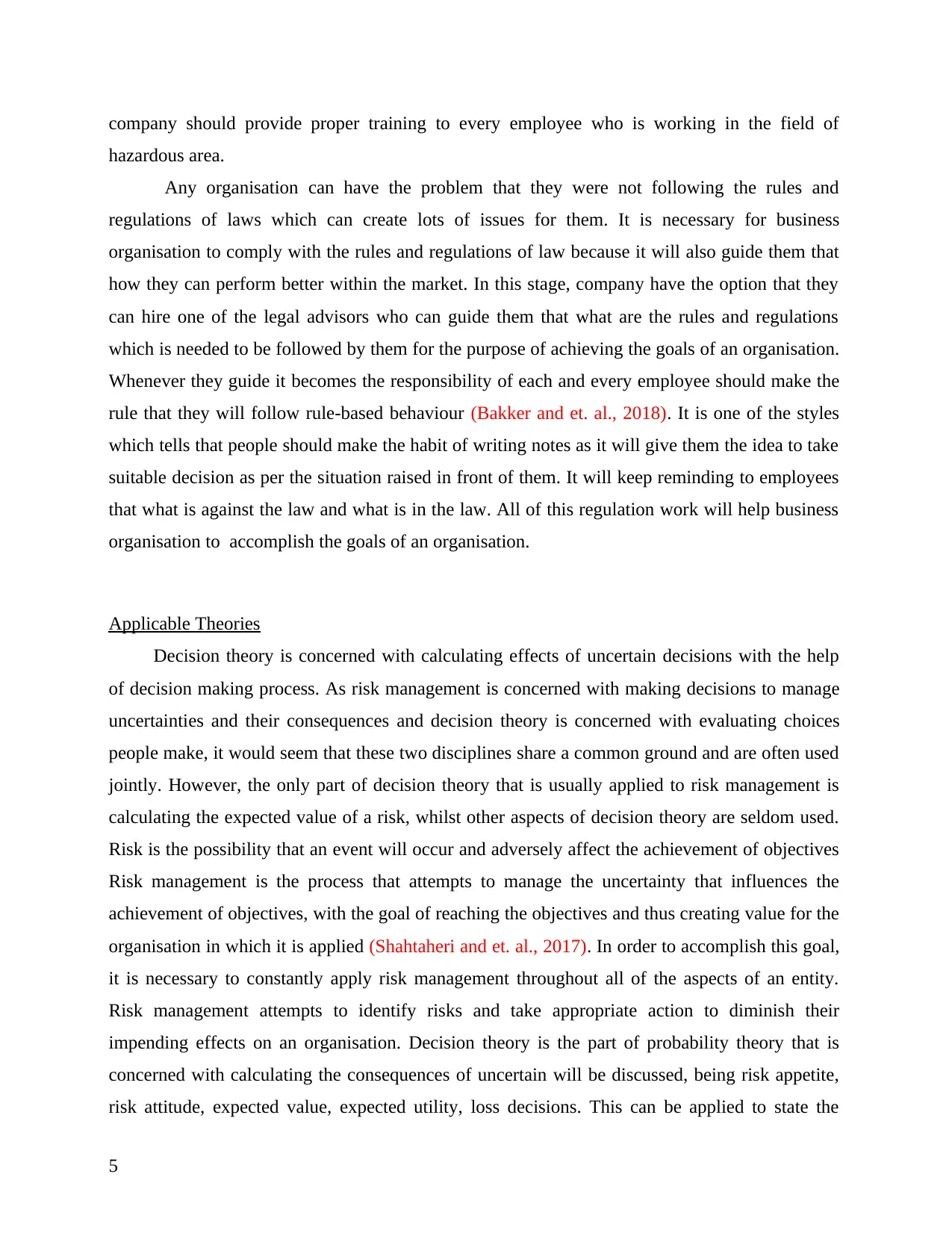
company should provide proper training to every employee who is working in the field of
hazardous area.
Any organisation can have the problem that they were not following the rules and
regulations of laws which can create lots of issues for them. It is necessary for business
organisation to comply with the rules and regulations of law because it will also guide them that
how they can perform better within the market. In this stage, company have the option that they
can hire one of the legal advisors who can guide them that what are the rules and regulations
which is needed to be followed by them for the purpose of achieving the goals of an organisation.
Whenever they guide it becomes the responsibility of each and every employee should make the
rule that they will follow rule-based behaviour (Bakker and et. al., 2018). It is one of the styles
which tells that people should make the habit of writing notes as it will give them the idea to take
suitable decision as per the situation raised in front of them. It will keep reminding to employees
that what is against the law and what is in the law. All of this regulation work will help business
organisation to accomplish the goals of an organisation.
Applicable Theories
Decision theory is concerned with calculating effects of uncertain decisions with the help
of decision making process. As risk management is concerned with making decisions to manage
uncertainties and their consequences and decision theory is concerned with evaluating choices
people make, it would seem that these two disciplines share a common ground and are often used
jointly. However, the only part of decision theory that is usually applied to risk management is
calculating the expected value of a risk, whilst other aspects of decision theory are seldom used.
Risk is the possibility that an event will occur and adversely affect the achievement of objectives
Risk management is the process that attempts to manage the uncertainty that influences the
achievement of objectives, with the goal of reaching the objectives and thus creating value for the
organisation in which it is applied (Shahtaheri and et. al., 2017). In order to accomplish this goal,
it is necessary to constantly apply risk management throughout all of the aspects of an entity.
Risk management attempts to identify risks and take appropriate action to diminish their
impending effects on an organisation. Decision theory is the part of probability theory that is
concerned with calculating the consequences of uncertain will be discussed, being risk appetite,
risk attitude, expected value, expected utility, loss decisions. This can be applied to state the
5
hazardous area.
Any organisation can have the problem that they were not following the rules and
regulations of laws which can create lots of issues for them. It is necessary for business
organisation to comply with the rules and regulations of law because it will also guide them that
how they can perform better within the market. In this stage, company have the option that they
can hire one of the legal advisors who can guide them that what are the rules and regulations
which is needed to be followed by them for the purpose of achieving the goals of an organisation.
Whenever they guide it becomes the responsibility of each and every employee should make the
rule that they will follow rule-based behaviour (Bakker and et. al., 2018). It is one of the styles
which tells that people should make the habit of writing notes as it will give them the idea to take
suitable decision as per the situation raised in front of them. It will keep reminding to employees
that what is against the law and what is in the law. All of this regulation work will help business
organisation to accomplish the goals of an organisation.
Applicable Theories
Decision theory is concerned with calculating effects of uncertain decisions with the help
of decision making process. As risk management is concerned with making decisions to manage
uncertainties and their consequences and decision theory is concerned with evaluating choices
people make, it would seem that these two disciplines share a common ground and are often used
jointly. However, the only part of decision theory that is usually applied to risk management is
calculating the expected value of a risk, whilst other aspects of decision theory are seldom used.
Risk is the possibility that an event will occur and adversely affect the achievement of objectives
Risk management is the process that attempts to manage the uncertainty that influences the
achievement of objectives, with the goal of reaching the objectives and thus creating value for the
organisation in which it is applied (Shahtaheri and et. al., 2017). In order to accomplish this goal,
it is necessary to constantly apply risk management throughout all of the aspects of an entity.
Risk management attempts to identify risks and take appropriate action to diminish their
impending effects on an organisation. Decision theory is the part of probability theory that is
concerned with calculating the consequences of uncertain will be discussed, being risk appetite,
risk attitude, expected value, expected utility, loss decisions. This can be applied to state the
5
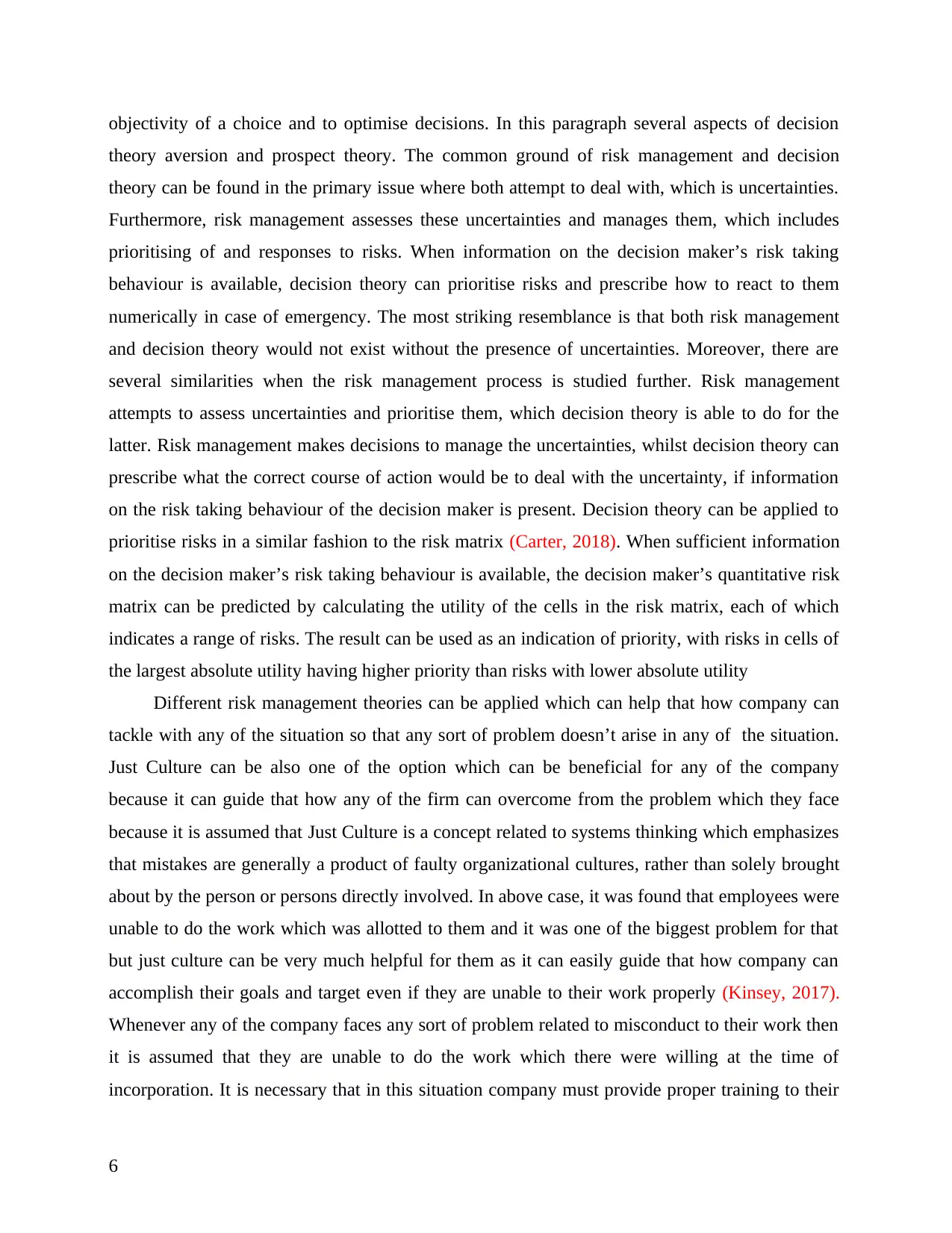
objectivity of a choice and to optimise decisions. In this paragraph several aspects of decision
theory aversion and prospect theory. The common ground of risk management and decision
theory can be found in the primary issue where both attempt to deal with, which is uncertainties.
Furthermore, risk management assesses these uncertainties and manages them, which includes
prioritising of and responses to risks. When information on the decision maker’s risk taking
behaviour is available, decision theory can prioritise risks and prescribe how to react to them
numerically in case of emergency. The most striking resemblance is that both risk management
and decision theory would not exist without the presence of uncertainties. Moreover, there are
several similarities when the risk management process is studied further. Risk management
attempts to assess uncertainties and prioritise them, which decision theory is able to do for the
latter. Risk management makes decisions to manage the uncertainties, whilst decision theory can
prescribe what the correct course of action would be to deal with the uncertainty, if information
on the risk taking behaviour of the decision maker is present. Decision theory can be applied to
prioritise risks in a similar fashion to the risk matrix (Carter, 2018). When sufficient information
on the decision maker’s risk taking behaviour is available, the decision maker’s quantitative risk
matrix can be predicted by calculating the utility of the cells in the risk matrix, each of which
indicates a range of risks. The result can be used as an indication of priority, with risks in cells of
the largest absolute utility having higher priority than risks with lower absolute utility
Different risk management theories can be applied which can help that how company can
tackle with any of the situation so that any sort of problem doesn’t arise in any of the situation.
Just Culture can be also one of the option which can be beneficial for any of the company
because it can guide that how any of the firm can overcome from the problem which they face
because it is assumed that Just Culture is a concept related to systems thinking which emphasizes
that mistakes are generally a product of faulty organizational cultures, rather than solely brought
about by the person or persons directly involved. In above case, it was found that employees were
unable to do the work which was allotted to them and it was one of the biggest problem for that
but just culture can be very much helpful for them as it can easily guide that how company can
accomplish their goals and target even if they are unable to their work properly (Kinsey, 2017).
Whenever any of the company faces any sort of problem related to misconduct to their work then
it is assumed that they are unable to do the work which there were willing at the time of
incorporation. It is necessary that in this situation company must provide proper training to their
6
theory aversion and prospect theory. The common ground of risk management and decision
theory can be found in the primary issue where both attempt to deal with, which is uncertainties.
Furthermore, risk management assesses these uncertainties and manages them, which includes
prioritising of and responses to risks. When information on the decision maker’s risk taking
behaviour is available, decision theory can prioritise risks and prescribe how to react to them
numerically in case of emergency. The most striking resemblance is that both risk management
and decision theory would not exist without the presence of uncertainties. Moreover, there are
several similarities when the risk management process is studied further. Risk management
attempts to assess uncertainties and prioritise them, which decision theory is able to do for the
latter. Risk management makes decisions to manage the uncertainties, whilst decision theory can
prescribe what the correct course of action would be to deal with the uncertainty, if information
on the risk taking behaviour of the decision maker is present. Decision theory can be applied to
prioritise risks in a similar fashion to the risk matrix (Carter, 2018). When sufficient information
on the decision maker’s risk taking behaviour is available, the decision maker’s quantitative risk
matrix can be predicted by calculating the utility of the cells in the risk matrix, each of which
indicates a range of risks. The result can be used as an indication of priority, with risks in cells of
the largest absolute utility having higher priority than risks with lower absolute utility
Different risk management theories can be applied which can help that how company can
tackle with any of the situation so that any sort of problem doesn’t arise in any of the situation.
Just Culture can be also one of the option which can be beneficial for any of the company
because it can guide that how any of the firm can overcome from the problem which they face
because it is assumed that Just Culture is a concept related to systems thinking which emphasizes
that mistakes are generally a product of faulty organizational cultures, rather than solely brought
about by the person or persons directly involved. In above case, it was found that employees were
unable to do the work which was allotted to them and it was one of the biggest problem for that
but just culture can be very much helpful for them as it can easily guide that how company can
accomplish their goals and target even if they are unable to their work properly (Kinsey, 2017).
Whenever any of the company faces any sort of problem related to misconduct to their work then
it is assumed that they are unable to do the work which there were willing at the time of
incorporation. It is necessary that in this situation company must provide proper training to their
6
⊘ This is a preview!⊘
Do you want full access?
Subscribe today to unlock all pages.

Trusted by 1+ million students worldwide
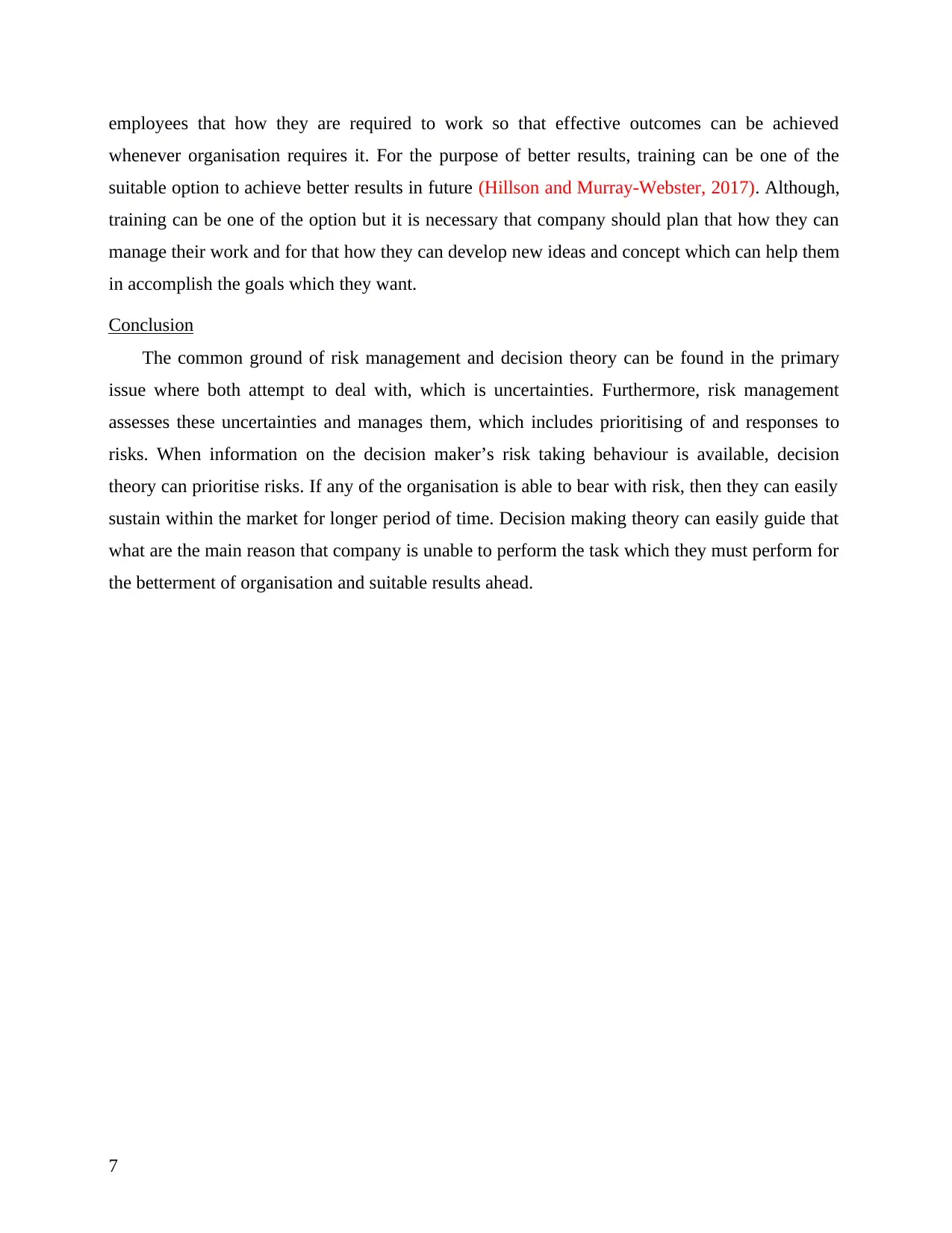
employees that how they are required to work so that effective outcomes can be achieved
whenever organisation requires it. For the purpose of better results, training can be one of the
suitable option to achieve better results in future (Hillson and Murray-Webster, 2017). Although,
training can be one of the option but it is necessary that company should plan that how they can
manage their work and for that how they can develop new ideas and concept which can help them
in accomplish the goals which they want.
Conclusion
The common ground of risk management and decision theory can be found in the primary
issue where both attempt to deal with, which is uncertainties. Furthermore, risk management
assesses these uncertainties and manages them, which includes prioritising of and responses to
risks. When information on the decision maker’s risk taking behaviour is available, decision
theory can prioritise risks. If any of the organisation is able to bear with risk, then they can easily
sustain within the market for longer period of time. Decision making theory can easily guide that
what are the main reason that company is unable to perform the task which they must perform for
the betterment of organisation and suitable results ahead.
7
whenever organisation requires it. For the purpose of better results, training can be one of the
suitable option to achieve better results in future (Hillson and Murray-Webster, 2017). Although,
training can be one of the option but it is necessary that company should plan that how they can
manage their work and for that how they can develop new ideas and concept which can help them
in accomplish the goals which they want.
Conclusion
The common ground of risk management and decision theory can be found in the primary
issue where both attempt to deal with, which is uncertainties. Furthermore, risk management
assesses these uncertainties and manages them, which includes prioritising of and responses to
risks. When information on the decision maker’s risk taking behaviour is available, decision
theory can prioritise risks. If any of the organisation is able to bear with risk, then they can easily
sustain within the market for longer period of time. Decision making theory can easily guide that
what are the main reason that company is unable to perform the task which they must perform for
the betterment of organisation and suitable results ahead.
7
Paraphrase This Document
Need a fresh take? Get an instant paraphrase of this document with our AI Paraphraser
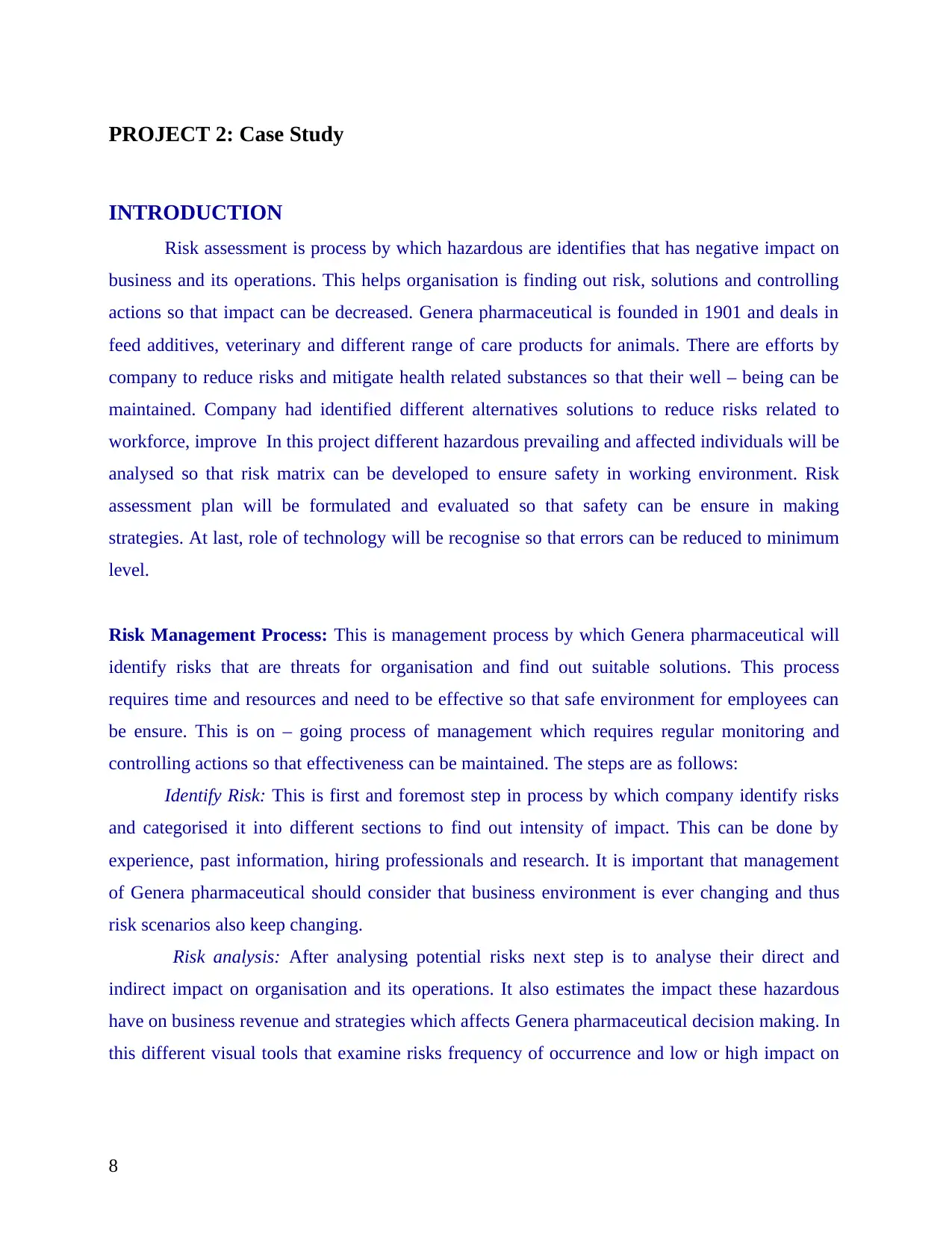
PROJECT 2: Case Study
INTRODUCTION
Risk assessment is process by which hazardous are identifies that has negative impact on
business and its operations. This helps organisation is finding out risk, solutions and controlling
actions so that impact can be decreased. Genera pharmaceutical is founded in 1901 and deals in
feed additives, veterinary and different range of care products for animals. There are efforts by
company to reduce risks and mitigate health related substances so that their well – being can be
maintained. Company had identified different alternatives solutions to reduce risks related to
workforce, improve In this project different hazardous prevailing and affected individuals will be
analysed so that risk matrix can be developed to ensure safety in working environment. Risk
assessment plan will be formulated and evaluated so that safety can be ensure in making
strategies. At last, role of technology will be recognise so that errors can be reduced to minimum
level.
Risk Management Process: This is management process by which Genera pharmaceutical will
identify risks that are threats for organisation and find out suitable solutions. This process
requires time and resources and need to be effective so that safe environment for employees can
be ensure. This is on – going process of management which requires regular monitoring and
controlling actions so that effectiveness can be maintained. The steps are as follows:
Identify Risk: This is first and foremost step in process by which company identify risks
and categorised it into different sections to find out intensity of impact. This can be done by
experience, past information, hiring professionals and research. It is important that management
of Genera pharmaceutical should consider that business environment is ever changing and thus
risk scenarios also keep changing.
Risk analysis: After analysing potential risks next step is to analyse their direct and
indirect impact on organisation and its operations. It also estimates the impact these hazardous
have on business revenue and strategies which affects Genera pharmaceutical decision making. In
this different visual tools that examine risks frequency of occurrence and low or high impact on
8
INTRODUCTION
Risk assessment is process by which hazardous are identifies that has negative impact on
business and its operations. This helps organisation is finding out risk, solutions and controlling
actions so that impact can be decreased. Genera pharmaceutical is founded in 1901 and deals in
feed additives, veterinary and different range of care products for animals. There are efforts by
company to reduce risks and mitigate health related substances so that their well – being can be
maintained. Company had identified different alternatives solutions to reduce risks related to
workforce, improve In this project different hazardous prevailing and affected individuals will be
analysed so that risk matrix can be developed to ensure safety in working environment. Risk
assessment plan will be formulated and evaluated so that safety can be ensure in making
strategies. At last, role of technology will be recognise so that errors can be reduced to minimum
level.
Risk Management Process: This is management process by which Genera pharmaceutical will
identify risks that are threats for organisation and find out suitable solutions. This process
requires time and resources and need to be effective so that safe environment for employees can
be ensure. This is on – going process of management which requires regular monitoring and
controlling actions so that effectiveness can be maintained. The steps are as follows:
Identify Risk: This is first and foremost step in process by which company identify risks
and categorised it into different sections to find out intensity of impact. This can be done by
experience, past information, hiring professionals and research. It is important that management
of Genera pharmaceutical should consider that business environment is ever changing and thus
risk scenarios also keep changing.
Risk analysis: After analysing potential risks next step is to analyse their direct and
indirect impact on organisation and its operations. It also estimates the impact these hazardous
have on business revenue and strategies which affects Genera pharmaceutical decision making. In
this different visual tools that examine risks frequency of occurrence and low or high impact on
8
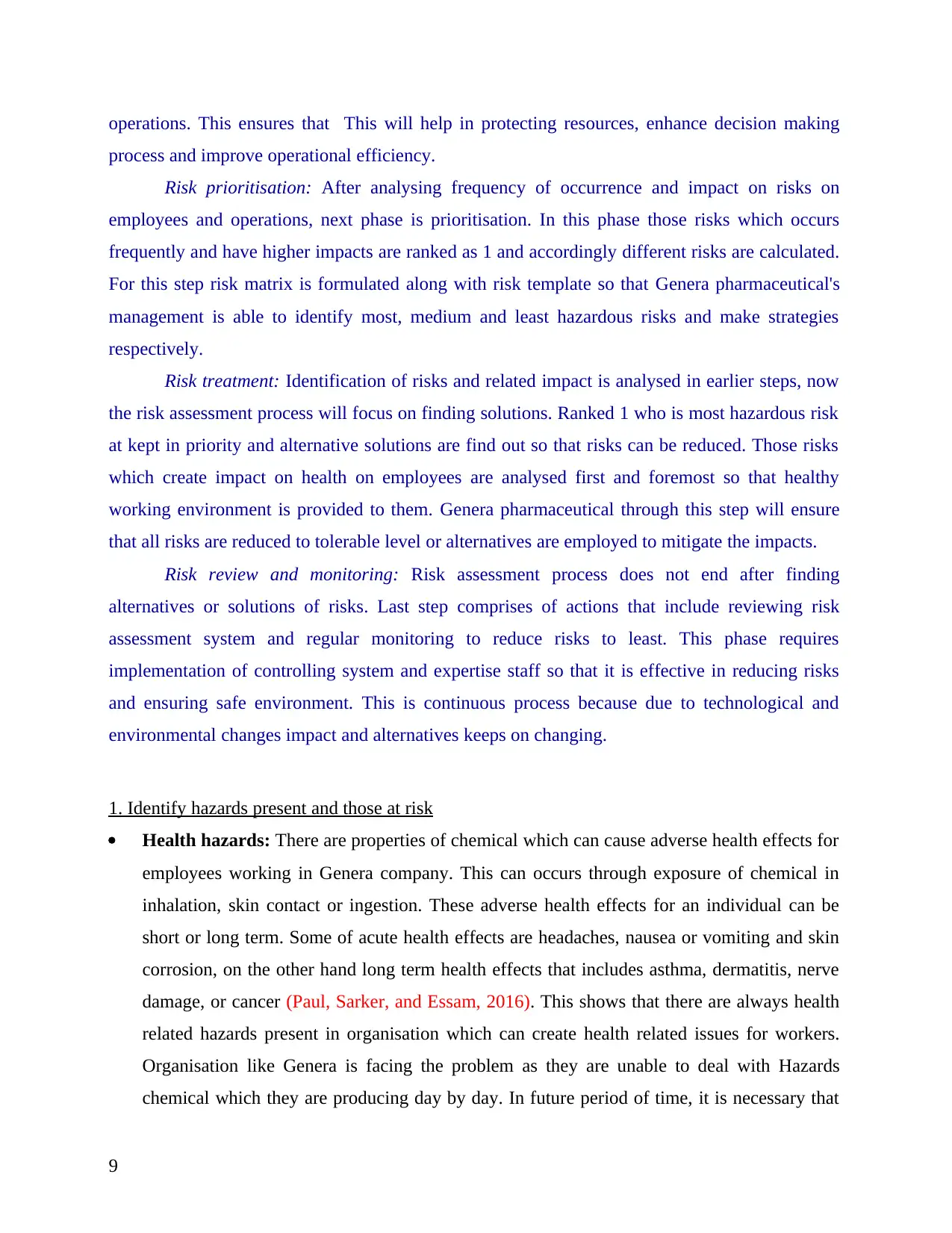
operations. This ensures that This will help in protecting resources, enhance decision making
process and improve operational efficiency.
Risk prioritisation: After analysing frequency of occurrence and impact on risks on
employees and operations, next phase is prioritisation. In this phase those risks which occurs
frequently and have higher impacts are ranked as 1 and accordingly different risks are calculated.
For this step risk matrix is formulated along with risk template so that Genera pharmaceutical's
management is able to identify most, medium and least hazardous risks and make strategies
respectively.
Risk treatment: Identification of risks and related impact is analysed in earlier steps, now
the risk assessment process will focus on finding solutions. Ranked 1 who is most hazardous risk
at kept in priority and alternative solutions are find out so that risks can be reduced. Those risks
which create impact on health on employees are analysed first and foremost so that healthy
working environment is provided to them. Genera pharmaceutical through this step will ensure
that all risks are reduced to tolerable level or alternatives are employed to mitigate the impacts.
Risk review and monitoring: Risk assessment process does not end after finding
alternatives or solutions of risks. Last step comprises of actions that include reviewing risk
assessment system and regular monitoring to reduce risks to least. This phase requires
implementation of controlling system and expertise staff so that it is effective in reducing risks
and ensuring safe environment. This is continuous process because due to technological and
environmental changes impact and alternatives keeps on changing.
1. Identify hazards present and those at risk
Health hazards: There are properties of chemical which can cause adverse health effects for
employees working in Genera company. This can occurs through exposure of chemical in
inhalation, skin contact or ingestion. These adverse health effects for an individual can be
short or long term. Some of acute health effects are headaches, nausea or vomiting and skin
corrosion, on the other hand long term health effects that includes asthma, dermatitis, nerve
damage, or cancer (Paul, Sarker, and Essam, 2016). This shows that there are always health
related hazards present in organisation which can create health related issues for workers.
Organisation like Genera is facing the problem as they are unable to deal with Hazards
chemical which they are producing day by day. In future period of time, it is necessary that
9
process and improve operational efficiency.
Risk prioritisation: After analysing frequency of occurrence and impact on risks on
employees and operations, next phase is prioritisation. In this phase those risks which occurs
frequently and have higher impacts are ranked as 1 and accordingly different risks are calculated.
For this step risk matrix is formulated along with risk template so that Genera pharmaceutical's
management is able to identify most, medium and least hazardous risks and make strategies
respectively.
Risk treatment: Identification of risks and related impact is analysed in earlier steps, now
the risk assessment process will focus on finding solutions. Ranked 1 who is most hazardous risk
at kept in priority and alternative solutions are find out so that risks can be reduced. Those risks
which create impact on health on employees are analysed first and foremost so that healthy
working environment is provided to them. Genera pharmaceutical through this step will ensure
that all risks are reduced to tolerable level or alternatives are employed to mitigate the impacts.
Risk review and monitoring: Risk assessment process does not end after finding
alternatives or solutions of risks. Last step comprises of actions that include reviewing risk
assessment system and regular monitoring to reduce risks to least. This phase requires
implementation of controlling system and expertise staff so that it is effective in reducing risks
and ensuring safe environment. This is continuous process because due to technological and
environmental changes impact and alternatives keeps on changing.
1. Identify hazards present and those at risk
Health hazards: There are properties of chemical which can cause adverse health effects for
employees working in Genera company. This can occurs through exposure of chemical in
inhalation, skin contact or ingestion. These adverse health effects for an individual can be
short or long term. Some of acute health effects are headaches, nausea or vomiting and skin
corrosion, on the other hand long term health effects that includes asthma, dermatitis, nerve
damage, or cancer (Paul, Sarker, and Essam, 2016). This shows that there are always health
related hazards present in organisation which can create health related issues for workers.
Organisation like Genera is facing the problem as they are unable to deal with Hazards
chemical which they are producing day by day. In future period of time, it is necessary that
9
⊘ This is a preview!⊘
Do you want full access?
Subscribe today to unlock all pages.

Trusted by 1+ million students worldwide
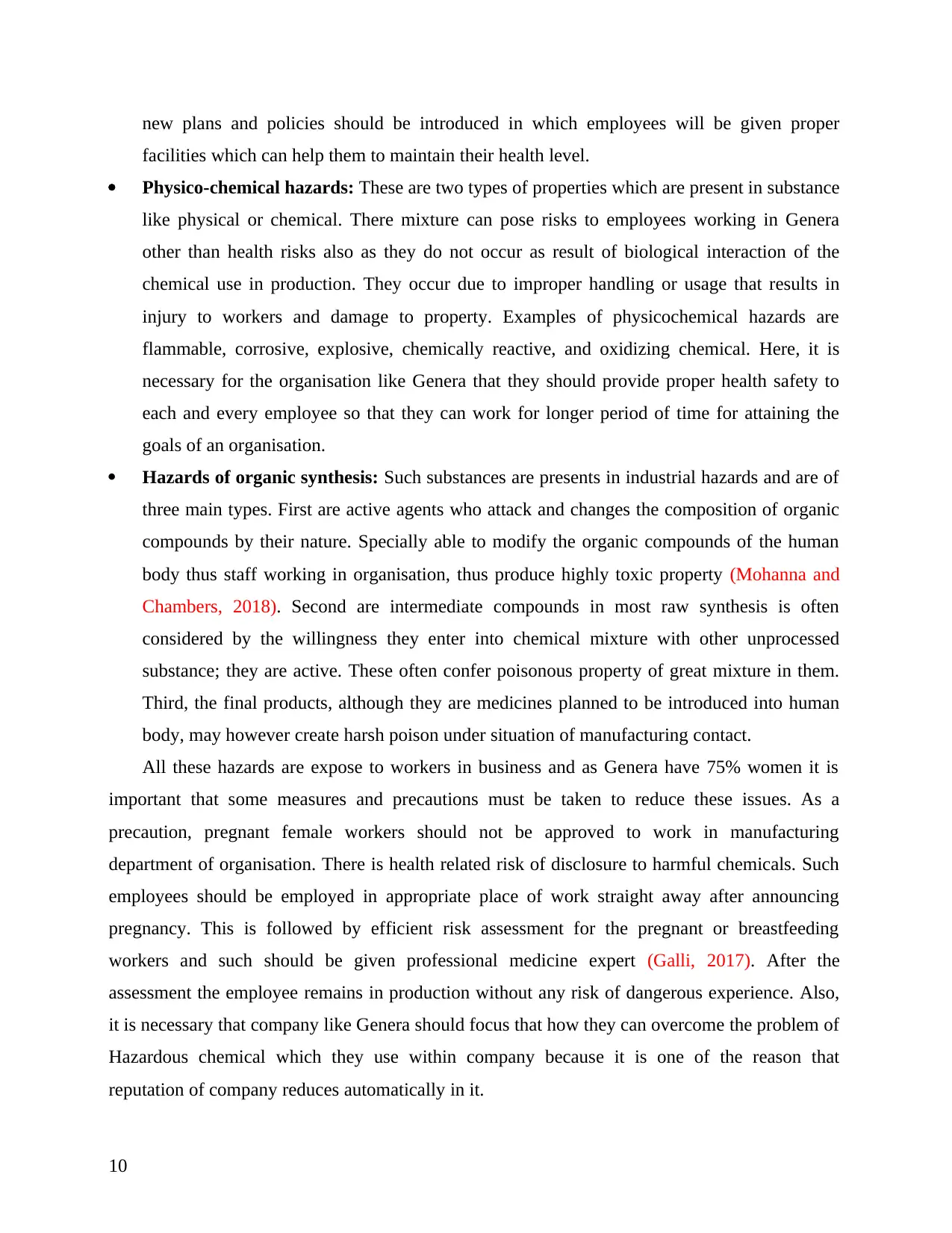
new plans and policies should be introduced in which employees will be given proper
facilities which can help them to maintain their health level.
Physico-chemical hazards: These are two types of properties which are present in substance
like physical or chemical. There mixture can pose risks to employees working in Genera
other than health risks also as they do not occur as result of biological interaction of the
chemical use in production. They occur due to improper handling or usage that results in
injury to workers and damage to property. Examples of physicochemical hazards are
flammable, corrosive, explosive, chemically reactive, and oxidizing chemical. Here, it is
necessary for the organisation like Genera that they should provide proper health safety to
each and every employee so that they can work for longer period of time for attaining the
goals of an organisation.
Hazards of organic synthesis: Such substances are presents in industrial hazards and are of
three main types. First are active agents who attack and changes the composition of organic
compounds by their nature. Specially able to modify the organic compounds of the human
body thus staff working in organisation, thus produce highly toxic property (Mohanna and
Chambers, 2018). Second are intermediate compounds in most raw synthesis is often
considered by the willingness they enter into chemical mixture with other unprocessed
substance; they are active. These often confer poisonous property of great mixture in them.
Third, the final products, although they are medicines planned to be introduced into human
body, may however create harsh poison under situation of manufacturing contact.
All these hazards are expose to workers in business and as Genera have 75% women it is
important that some measures and precautions must be taken to reduce these issues. As a
precaution, pregnant female workers should not be approved to work in manufacturing
department of organisation. There is health related risk of disclosure to harmful chemicals. Such
employees should be employed in appropriate place of work straight away after announcing
pregnancy. This is followed by efficient risk assessment for the pregnant or breastfeeding
workers and such should be given professional medicine expert (Galli, 2017). After the
assessment the employee remains in production without any risk of dangerous experience. Also,
it is necessary that company like Genera should focus that how they can overcome the problem of
Hazardous chemical which they use within company because it is one of the reason that
reputation of company reduces automatically in it.
10
facilities which can help them to maintain their health level.
Physico-chemical hazards: These are two types of properties which are present in substance
like physical or chemical. There mixture can pose risks to employees working in Genera
other than health risks also as they do not occur as result of biological interaction of the
chemical use in production. They occur due to improper handling or usage that results in
injury to workers and damage to property. Examples of physicochemical hazards are
flammable, corrosive, explosive, chemically reactive, and oxidizing chemical. Here, it is
necessary for the organisation like Genera that they should provide proper health safety to
each and every employee so that they can work for longer period of time for attaining the
goals of an organisation.
Hazards of organic synthesis: Such substances are presents in industrial hazards and are of
three main types. First are active agents who attack and changes the composition of organic
compounds by their nature. Specially able to modify the organic compounds of the human
body thus staff working in organisation, thus produce highly toxic property (Mohanna and
Chambers, 2018). Second are intermediate compounds in most raw synthesis is often
considered by the willingness they enter into chemical mixture with other unprocessed
substance; they are active. These often confer poisonous property of great mixture in them.
Third, the final products, although they are medicines planned to be introduced into human
body, may however create harsh poison under situation of manufacturing contact.
All these hazards are expose to workers in business and as Genera have 75% women it is
important that some measures and precautions must be taken to reduce these issues. As a
precaution, pregnant female workers should not be approved to work in manufacturing
department of organisation. There is health related risk of disclosure to harmful chemicals. Such
employees should be employed in appropriate place of work straight away after announcing
pregnancy. This is followed by efficient risk assessment for the pregnant or breastfeeding
workers and such should be given professional medicine expert (Galli, 2017). After the
assessment the employee remains in production without any risk of dangerous experience. Also,
it is necessary that company like Genera should focus that how they can overcome the problem of
Hazardous chemical which they use within company because it is one of the reason that
reputation of company reduces automatically in it.
10
Paraphrase This Document
Need a fresh take? Get an instant paraphrase of this document with our AI Paraphraser
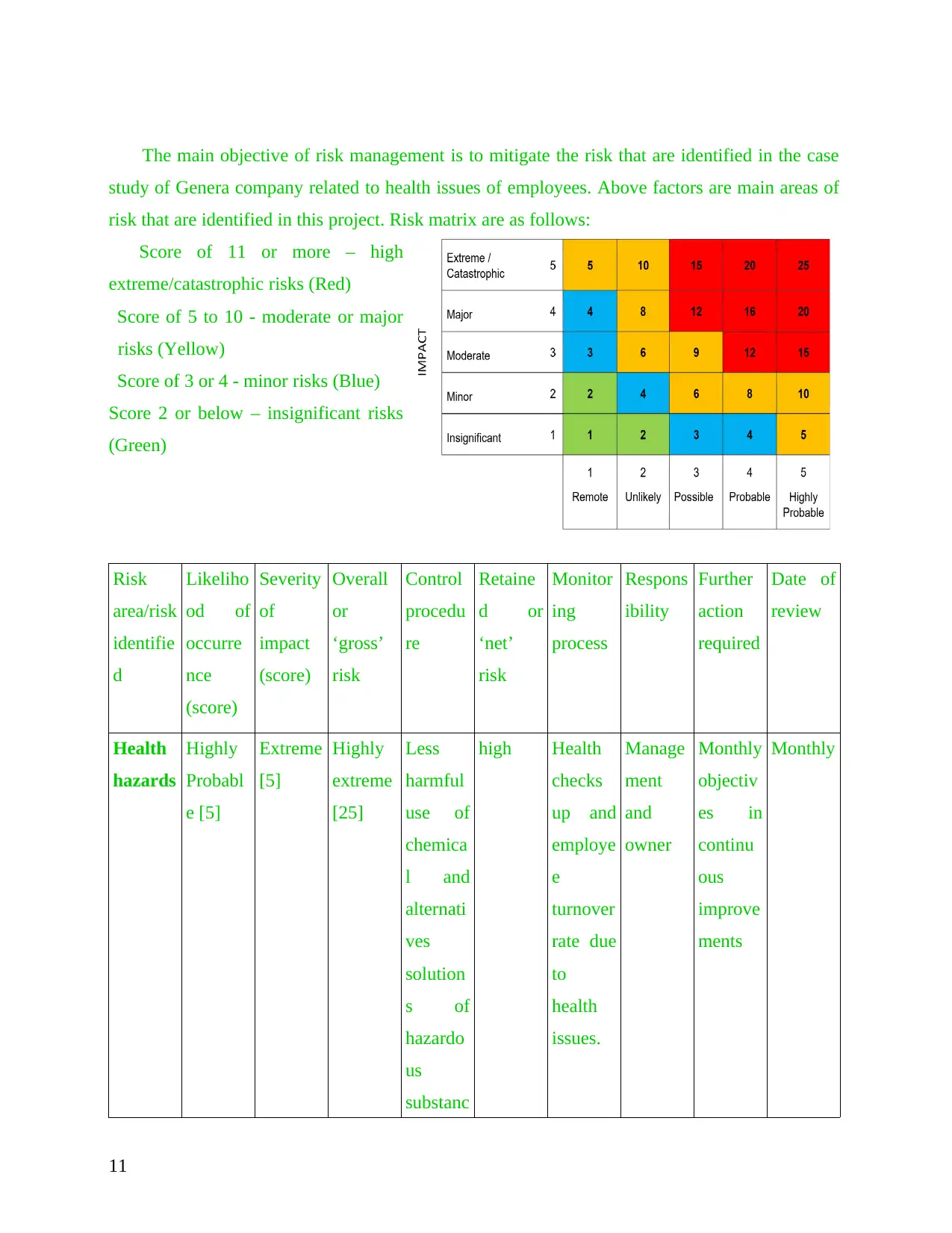
The main objective of risk management is to mitigate the risk that are identified in the case
study of Genera company related to health issues of employees. Above factors are main areas of
risk that are identified in this project. Risk matrix are as follows:
Score of 11 or more – high
extreme/catastrophic risks (Red)
Score of 5 to 10 - moderate or major
risks (Yellow)
Score of 3 or 4 - minor risks (Blue)
Score 2 or below – insignificant risks
(Green)
Risk
area/risk
identifie
d
Likeliho
od of
occurre
nce
(score)
Severity
of
impact
(score)
Overall
or
‘gross’
risk
Control
procedu
re
Retaine
d or
‘net’
risk
Monitor
ing
process
Respons
ibility
Further
action
required
Date of
review
Health
hazards
Highly
Probabl
e [5]
Extreme
[5]
Highly
extreme
[25]
Less
harmful
use of
chemica
l and
alternati
ves
solution
s of
hazardo
us
substanc
high Health
checks
up and
employe
e
turnover
rate due
to
health
issues.
Manage
ment
and
owner
Monthly
objectiv
es in
continu
ous
improve
ments
Monthly
11
study of Genera company related to health issues of employees. Above factors are main areas of
risk that are identified in this project. Risk matrix are as follows:
Score of 11 or more – high
extreme/catastrophic risks (Red)
Score of 5 to 10 - moderate or major
risks (Yellow)
Score of 3 or 4 - minor risks (Blue)
Score 2 or below – insignificant risks
(Green)
Risk
area/risk
identifie
d
Likeliho
od of
occurre
nce
(score)
Severity
of
impact
(score)
Overall
or
‘gross’
risk
Control
procedu
re
Retaine
d or
‘net’
risk
Monitor
ing
process
Respons
ibility
Further
action
required
Date of
review
Health
hazards
Highly
Probabl
e [5]
Extreme
[5]
Highly
extreme
[25]
Less
harmful
use of
chemica
l and
alternati
ves
solution
s of
hazardo
us
substanc
high Health
checks
up and
employe
e
turnover
rate due
to
health
issues.
Manage
ment
and
owner
Monthly
objectiv
es in
continu
ous
improve
ments
Monthly
11
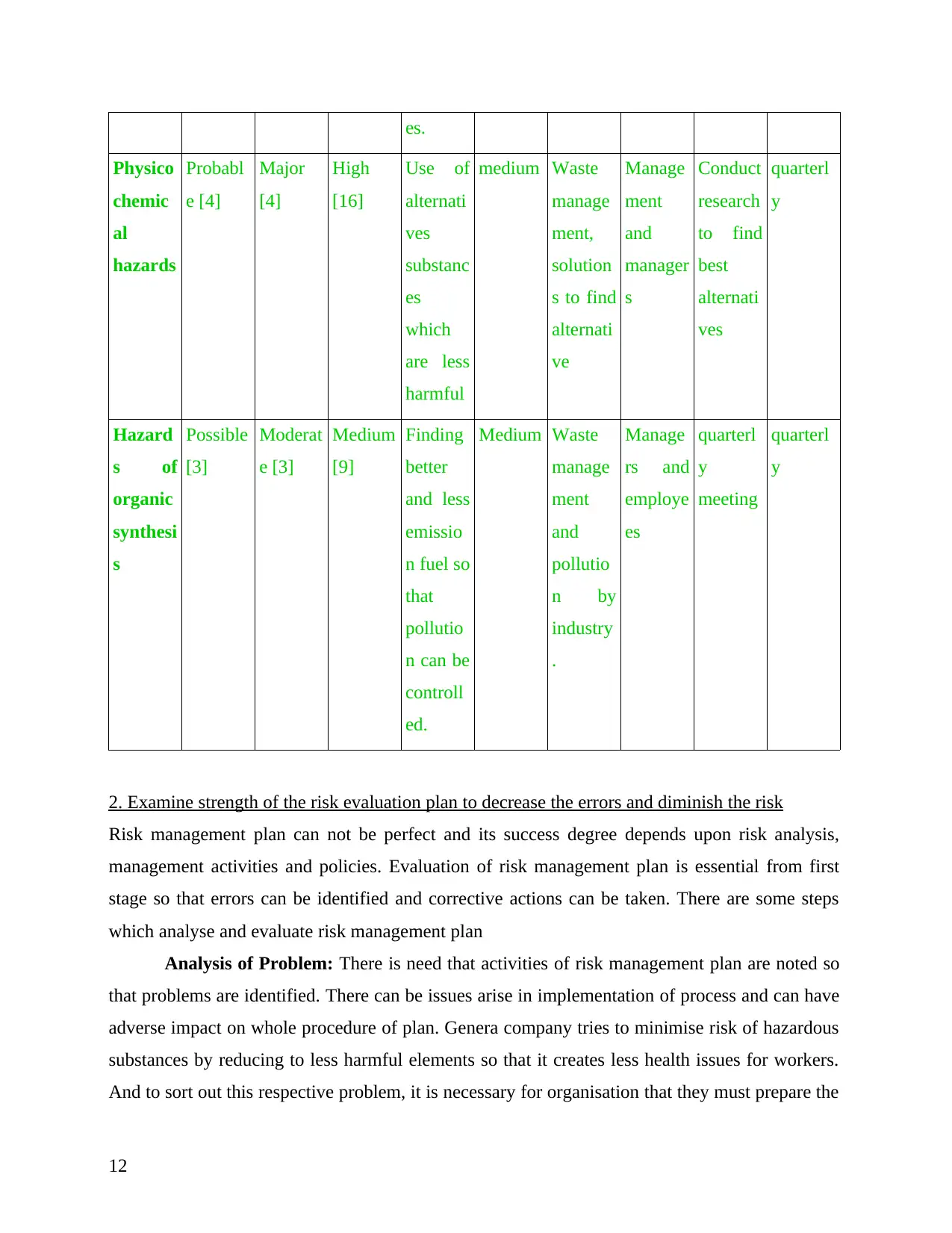
es.
Physico
chemic
al
hazards
Probabl
e [4]
Major
[4]
High
[16]
Use of
alternati
ves
substanc
es
which
are less
harmful
medium Waste
manage
ment,
solution
s to find
alternati
ve
Manage
ment
and
manager
s
Conduct
research
to find
best
alternati
ves
quarterl
y
Hazard
s of
organic
synthesi
s
Possible
[3]
Moderat
e [3]
Medium
[9]
Finding
better
and less
emissio
n fuel so
that
pollutio
n can be
controll
ed.
Medium Waste
manage
ment
and
pollutio
n by
industry
.
Manage
rs and
employe
es
quarterl
y
meeting
quarterl
y
2. Examine strength of the risk evaluation plan to decrease the errors and diminish the risk
Risk management plan can not be perfect and its success degree depends upon risk analysis,
management activities and policies. Evaluation of risk management plan is essential from first
stage so that errors can be identified and corrective actions can be taken. There are some steps
which analyse and evaluate risk management plan
Analysis of Problem: There is need that activities of risk management plan are noted so
that problems are identified. There can be issues arise in implementation of process and can have
adverse impact on whole procedure of plan. Genera company tries to minimise risk of hazardous
substances by reducing to less harmful elements so that it creates less health issues for workers.
And to sort out this respective problem, it is necessary for organisation that they must prepare the
12
Physico
chemic
al
hazards
Probabl
e [4]
Major
[4]
High
[16]
Use of
alternati
ves
substanc
es
which
are less
harmful
medium Waste
manage
ment,
solution
s to find
alternati
ve
Manage
ment
and
manager
s
Conduct
research
to find
best
alternati
ves
quarterl
y
Hazard
s of
organic
synthesi
s
Possible
[3]
Moderat
e [3]
Medium
[9]
Finding
better
and less
emissio
n fuel so
that
pollutio
n can be
controll
ed.
Medium Waste
manage
ment
and
pollutio
n by
industry
.
Manage
rs and
employe
es
quarterl
y
meeting
quarterl
y
2. Examine strength of the risk evaluation plan to decrease the errors and diminish the risk
Risk management plan can not be perfect and its success degree depends upon risk analysis,
management activities and policies. Evaluation of risk management plan is essential from first
stage so that errors can be identified and corrective actions can be taken. There are some steps
which analyse and evaluate risk management plan
Analysis of Problem: There is need that activities of risk management plan are noted so
that problems are identified. There can be issues arise in implementation of process and can have
adverse impact on whole procedure of plan. Genera company tries to minimise risk of hazardous
substances by reducing to less harmful elements so that it creates less health issues for workers.
And to sort out this respective problem, it is necessary for organisation that they must prepare the
12
⊘ This is a preview!⊘
Do you want full access?
Subscribe today to unlock all pages.

Trusted by 1+ million students worldwide
1 out of 17
Related Documents
Your All-in-One AI-Powered Toolkit for Academic Success.
+13062052269
info@desklib.com
Available 24*7 on WhatsApp / Email
![[object Object]](/_next/static/media/star-bottom.7253800d.svg)
Unlock your academic potential
Copyright © 2020–2025 A2Z Services. All Rights Reserved. Developed and managed by ZUCOL.





